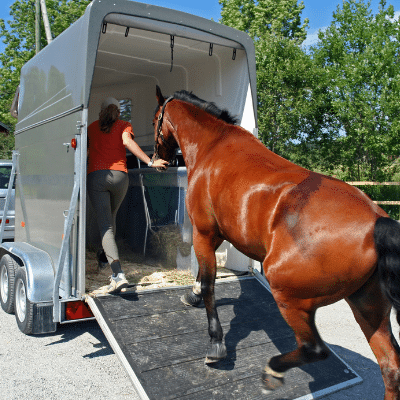How to Move with Horses
Moving is an exciting time in a person’s life, but those who own horses have additional considerations to think about. In fact, when it comes to moving with horses or ponies, many equestrian folks are caught off guard and are unsure how, exactly, can they move with horses.
There is so much to think about!
For instance, how do you make sure a horse is physically fit to move? How do you transport a horse long distances? What potential trailer-related injuries should you be aware of? If the idea of how to move with horses is stressing you out…take a deep breath.
Amazing Spaces is here with everything horse parents need to know.

Get Their New Stall and Paddock Ready Before You Move with Horses
Moving a horse locally or cross-country will require that you take different steps, depending on how far away their new home is. But one thing that stays the same is the need to prepare their new accommodations ahead of time. Before you even think about loading up the trailer, first ask yourself, “Where will my horse be staying once we arrive?”
Many horse owners choose to board. Ideally, you will visit a boarding facility weeks or months in advance. Almost all require a deposit. So, be sure to make booking arrangements early.
On the other hand (or hoof…that’s a horse joke!) if you are lucky enough to be moving to a home with acreage and a barn, then it becomes your responsibility to prepare your horse’s new quarters yourself.
This includes checking the pastures for toxic/poisonous plants, doublechecking that all fences are secure, changing the locks on gates, and getting their stall ready.
A barn stall should be tall and wide enough to comfortably fit your horse, plus offer natural lighting, warmth, and a place for food and water.
Inheriting a barn? Don’t forget to have an electrician do a safety check on the wiring.
Talk to Your Horse’s Veterinarian When Planning to Move with Horses
Next, your veterinarian will need to visit.
This is an opportunity for them to perform a full body exam. Ensuring that your horse or pony is in tiptop shape is the best preventative medicine when it comes to moving.
Furthermore, if crossing state lines or international borders, it is highly likely that your pet will need to be up to date on their vaccinations. This includes a Coggins test (a blood test that screens for a disease called Equine Infectious Anemia), as explained by Equus Magazine.
Transporting your horse internationally? Check both the exit and entrance requirements.


Trailer, Air, or Ship? Decide How to Transport Your Horse
Depending on how far you are traveling with your horse, you will need to decide which method of horse transportation to use. Consider the following pros and cons:
Trailer
Ideal for shorter distances (9 hours max). Trailers are great options for people who want to transport their own animals. Trailers are also an affordable choice, with many equine companies offering rentals. On the downside, frequent stops are necessary to check on your horse.
It can also be stressful to drive with a trailer hitched, especially in poor weather conditions like rain, wind, and snow.
Air
A second choice is to fly your horse. Unfortunately, air transportation is expensive. Owners should be prepared to pay thousands (and sometimes tens of thousands) of dollars to fly their four-legged friend. However, on the plus side, air travel is fast. Unlike in a trailer or on a ship, a plane flies relatively smoothly – with no potholes or topsy turvy waves!
Therefore, flying a horse can surprisingly be a more comfortable option.
Ship
Thirdly, we have boats. This is the least popular horse transportation method because it is slow, causes equine nausea, and is extremely difficult to book. International travelers who are moving to a new home overseas are better off using air transportation.
No matter which option you choose, the most important thing is to do research ahead of time before you plan to move with horses.
How to Prevent Trailer-related Injuries in Horses
It is a horse parent’s worst nightmare: an injury occurs during transport.
Despite all our meticulous planning, accidents happen. That’s why it’s key to have an equine first aid kit. Equine Spot kindly offers a free to downloadable list of must-have horse first aid items. This includes gauze/sanitary pads, cotton rolls, gloves, vet wrap, clippers, tweezers, and an assortment of medications.
In addition, to prevent trailer-related injuries from happening, be sure to do the following:
- Inspect the trailer for damage
- Add rubber floor mats
- Test car and trailer brakes, tires, and hitches
- Watch the weather. Slipper or icy road conditions heighten the risk of accidents
- Make frequent break stops
- Use padding to minimize dust
- Offer hay to nibble
- Secure any stall dividers
- Always use “quick release” snaps on halters and ropes

Soon, your horse will arrive happy and healthy at their new home. Using our amazing moving tips guide, moving with a horse or pony has never been easier!



